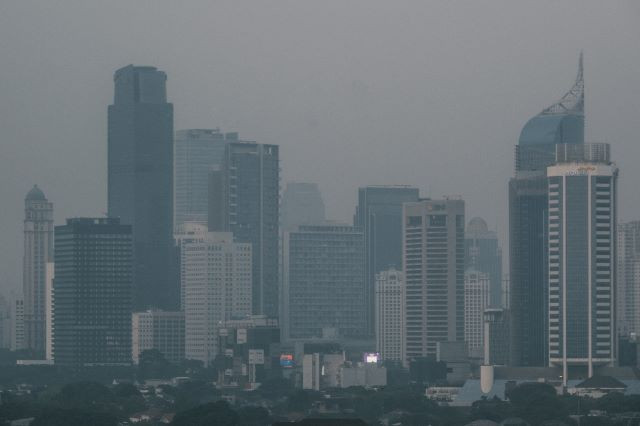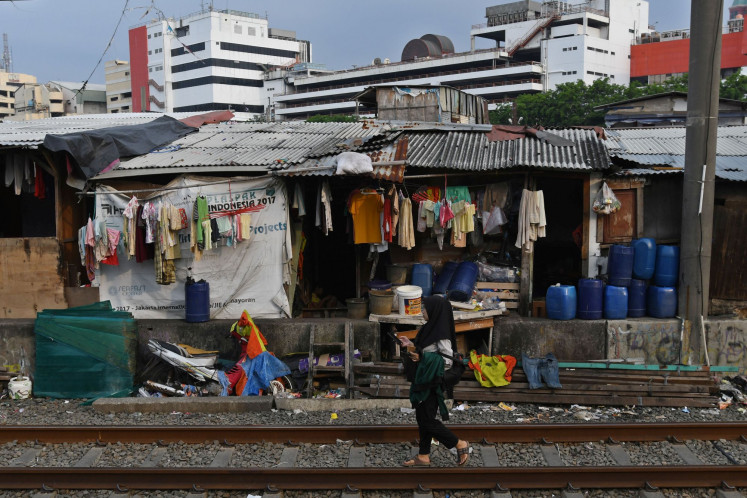Popular Reads
Top Results
Can't find what you're looking for?
View all search resultsPopular Reads
Top Results
Can't find what you're looking for?
View all search resultsAnalysis: Dealing with urban agglomeration challenges in Indonesia
Jakarta is the largest metropolitan area in Southeast Asia, with a tremendous rate of population growth and wide range of urban problems
Change text size
Gift Premium Articles
to Anyone

Jakarta is the largest metropolitan area in Southeast Asia, with a tremendous rate of population growth and wide range of urban problems.
Research from Han and Basuki in 2001 found that the overall population of Jakarta increased 100 times in the 20th century, from about 100,000 people in 1900 to more than 9 million people in 1995.
Meanwhile, the total population of Jakarta has decreased in the last five years of the past decade, from 9.1 million in 1995 as recorded by a 1995 Central Statistics Agency (BPS) survey, to 8.4 million in 2000, according to the 2000 national population census.
The decrease in Jakarta's population in 1995-2000 was caused by suburbanization. Jakarta's satellite cities of Bogor, Tangerang, Depok and Bekasi (Bodetabek) have seen a drastic increase in population. The population of Bodetabek has tripled from 4.4 million in 1980 to 12.6 million in 2000, while Jakarta's population increased by only 30 percent.
Based on the city's population data, Jabodetabek ' the above satellite cities along with Jakarta ' became the world's fourth largest urban agglomeration area in July 2014. Many moderate and high-income families moved from the city center to the suburbs. They were attracted by high-quality amenities provided by suburban enclave housing.
The UN in the 2014 World Urbanization Prospects report stated that more than half of the world's population or 52.1 percent lived in urban areas in 2011.
This figure would continue to increase and was expected to reach 59.9 percent in 2030 and 67.2 percent in 2050. In Asia, the UN estimated that half of the population would be in urban areas by 2020. Further, the UN estimated that by 2025 about 60.3 percent of Indonesia's population would live in urban areas.
A World Bank study in 2012 confirmed that the majority of Indonesia's population ' 51 percent ' lived in urban areas, a central trigger of which was ongoing urbanization. The country's urbanization rate also showed that Indonesia had the most rapid growth compared to other countries in Asia. Such growth was expected to continue.
The World Bank predicted that by 2025, 68 percent of Indonesia's population would live in urban areas. From 1993 to 2007, the World Bank recorded an average annual rate of urbanization in Indonesia of 4.2 percent.
The rapid pace of urbanization shows that people also choose to live in urban areas. It also provides economic added value to urban areas. Urban development in Indonesia shows a structural transition. Indonesia's structural transition has occurred due to its shift from a country that was initially dominated by an agricultural and rural economy into an urban economy driven by the manufacturing and service sectors. The World Bank also noted that in 2010, approximately 74 percent of gross domestic product was generated by urban areas.
In fact, today's urban agglomeration can be attributed to an increase in output and productivity. The increasing concentration of the population as a result of urbanization is not only bringing challenges, but is also facilitating the provision of primary care by the government, such as education and health, more efficiently. The industrial concentration in urban areas allows the common use of infrastructure, thus lowering costs, and proximity with various value chain contributors to help the efficiency of production processes.
With the shift of the Indonesian economy toward an industrial country, industrial concentration will encourage competition, which in turn will spur innovation. To be globally competitive, companies must be located in places that provide a good quality of life and infrastructure connectivity to be sought by workers with high skill levels.
Some metropolitan areas have long established themselves as centers of economic and social activities in their respective areas. However, it is undeniable that there are other growth centers than metropolitan areas. The other areas are often referred to as agglomeration areas, the surrounding areas that meet the criteria of population density and minimum connectivity in relation to the urban center.
The million dollar question is how to boost Indonesia's socio-economic development to a much higher level through agglomeration. It requires different strategies and from all sides to manage agglomeration to achieve optimum growth. Coordinated policies in urban areas are critical to know how the cities and the surrounding agglomerations work as centers of economic activities.
The advantages of agglomeration especially for industries are as follows.
First, production linkage. In this linkage, goods move from a company to another as a series of industrial processes.
Second, service linkage. Basically, a company will not be able to meet its own requirements. One of the requirements needed by a company is the service linkage of other companies.
Third, market linkage. Market linkage will involve a separate section, which is part of the duty to sell and distribute industrial products. In this sense, there is a linkage between a packaging manufacturer and sales agents. The linkage is very important to distribute the products to end consumers.
In the agglomeration areas, the coordination of strategic infrastructure investments and regional economic development are critical. Currently, the administrative boundaries of existing metropolitan areas do not properly reflect the spatial limits of economic activities or regional market dynamics, so that problems that affect the market and these activities should be coordinated across administrative boundaries.
Indonesia's transformation from a rural to majority urban country is progressing rapidly, and poses significant challenges, mainly those related to the long-term impacts of urbanization for the economy, society and environment.
At this stage, Indonesia has a valuable opportunity to drive urbanization and agglomeration appropriately before it is stuck to a spatial structure requiring costly repair. However, the huge potential benefits that could fulfilled need to be followed by appropriate investments and policies. In the end, Indonesia has reason to be optimistic about the future of urban development.
In Jakarta, a policy on the capacity building of human resources is needed to create a prosperous urban condition and simultaneously reduce the amount of poor urban people, preparing urban communities to play an active role in organizing urban development, as well as providing a skilled workforce capable of entering the labor market in urban areas. The most important support is the availability of basic infrastructure to facilitate people in the region doing their day-to-day activities.
______________
The writer is a junior economist, office of chief economist (OCE) PT. Bank Mandiri (Persero) Tbk.









